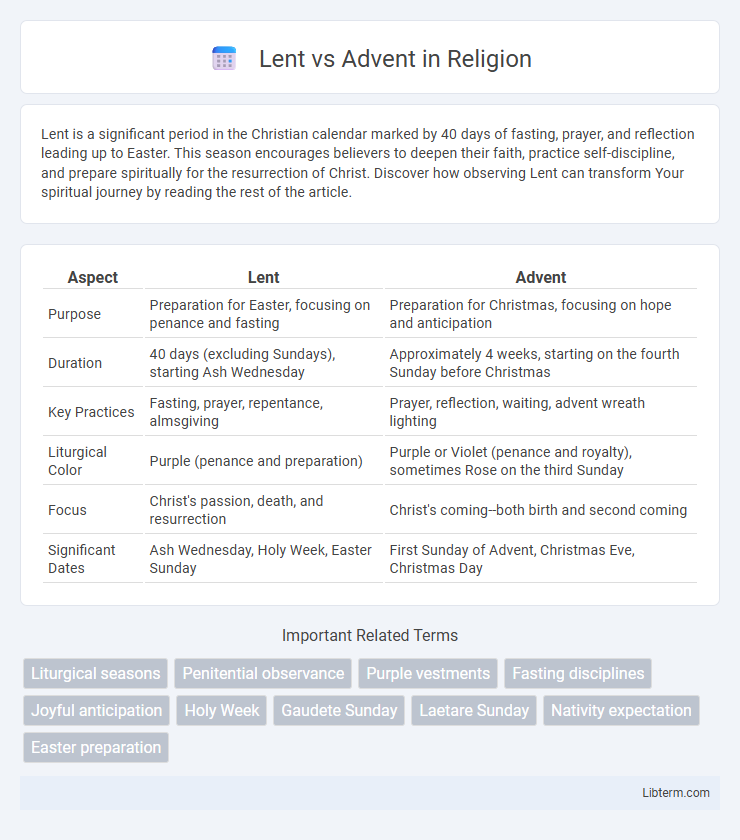Lent is a significant period in the Christian calendar marked by 40 days of fasting, prayer, and reflection leading up to Easter. This season encourages believers to deepen their faith, practice self-discipline, and prepare spiritually for the resurrection of Christ. Discover how observing Lent can transform Your spiritual journey by reading the rest of the article.
Table of Comparison
| Aspect | Lent | Advent |
|---|---|---|
| Purpose | Preparation for Easter, focusing on penance and fasting | Preparation for Christmas, focusing on hope and anticipation |
| Duration | 40 days (excluding Sundays), starting Ash Wednesday | Approximately 4 weeks, starting on the fourth Sunday before Christmas |
| Key Practices | Fasting, prayer, repentance, almsgiving | Prayer, reflection, waiting, advent wreath lighting |
| Liturgical Color | Purple (penance and preparation) | Purple or Violet (penance and royalty), sometimes Rose on the third Sunday |
| Focus | Christ's passion, death, and resurrection | Christ's coming--both birth and second coming |
| Significant Dates | Ash Wednesday, Holy Week, Easter Sunday | First Sunday of Advent, Christmas Eve, Christmas Day |
Introduction to Lent and Advent
Lent and Advent are liturgical seasons observed in many Christian traditions, each serving as a time of spiritual preparation and reflection. Lent spans 40 days leading up to Easter, emphasizing penance, fasting, and repentance to commemorate Jesus Christ's sacrifice. Advent, lasting about four weeks before Christmas, focuses on anticipation and hope, preparing believers for the celebration of Jesus' birth and His eventual second coming.
Historical Origins of Lent and Advent
Lent originated in the early Christian Church as a 40-day period of fasting and penance commemorating Jesus Christ's 40 days in the wilderness, with its roots traceable to the 4th century. Advent developed later, emerging around the 5th or 6th century, serving as a preparatory season for Christmas and symbolizing anticipation of Christ's coming. Both liturgical seasons reflect significant theological themes, with Lent emphasizing repentance and renewal, while Advent centers on hope and expectation.
Purpose and Significance of Each Season
Lent is a 40-day period of fasting, prayer, and penance preparing Christians for Easter, emphasizing repentance and spiritual renewal. Advent spans four weeks leading up to Christmas, focusing on anticipation and hope as believers await the birth of Jesus Christ. Both seasons serve as crucial times for reflection, with Lent highlighting sacrifice and Advent fostering joyful expectation.
Key Traditions and Practices
Lent centers on fasting, prayer, and almsgiving over 40 days to prepare for Easter, often marked by Ash Wednesday and the abstention from meat on Fridays. Advent spans four weeks of anticipation for Christmas, emphasizing lighting Advent wreath candles, daily scripture readings, and joyful reflection. Both seasons involve liturgical colors--purple for Lent symbolizing penance and violet or blue for Advent representing hope and preparation.
Symbolic Colors and Their Meanings
Lent is symbolized by the color purple, representing penance, preparation, and sacrifice, emphasizing reflection and repentance in the Christian tradition. Advent's primary color is also purple, but it conveys hope, anticipation, and royalty as believers prepare for the celebration of Christ's birth. Rose is used on the third Sunday of both seasons, symbolizing joy amidst penitence during Lent's Laetare Sunday and the hopeful progress of Advent's Gaudete Sunday.
Duration and Timing in the Liturgical Calendar
Lent spans approximately 40 days, beginning on Ash Wednesday and concluding on Holy Saturday, immediately preceding Easter Sunday, reflecting Jesus Christ's fasting period in the desert. Advent lasts about four weeks, starting on the fourth Sunday before Christmas and ending on Christmas Eve, marking the anticipation of Christ's birth. Both seasons are integral to the liturgical calendar, with Lent emphasizing penitence and preparation for Easter, while Advent focuses on expectant waiting and preparation for Christmas.
Fasting and Feasting: Differences in Observance
Lent involves 40 days of fasting, repentance, and spiritual discipline leading up to Easter, characterized by abstaining from meat, dairy, and indulgent foods, focusing on simplicity and prayer. Advent, spanning four weeks before Christmas, emphasizes preparation and anticipation, often marked by small daily rituals rather than strict fasting, with occasional feasting on special days like St. Nicholas Day. While Lent prioritizes sacrifice and restraint, Advent balances reflective fasting with joyous feasting to celebrate the coming of Christ.
Scriptural Readings and Themes
Lent centers on penitence and spiritual renewal through scriptural readings from the Gospels, emphasizing Christ's Passion, repentance, and baptismal preparation, often drawn from Isaiah, Psalms, and the Letters of Paul. Advent's readings highlight hope, anticipation, and the coming of Christ, featuring prophetic passages from Isaiah and New Testament texts like the Gospel of Luke, focusing on themes of preparation and the fulfillment of God's promises. Both seasons guide the faithful through transformative journeys, with Lent concentrating on sacrifice and redemption, while Advent emphasizes expectant waiting and divine promise.
Impact on Christian Communities
Lent and Advent each profoundly shape Christian communities by fostering spiritual reflection and communal discipline through distinct practices; Lent centers on repentance, fasting, and almsgiving in preparation for Easter, encouraging self-examination and renewal. Advent emphasizes anticipation and hope during the weeks leading to Christmas, promoting prayerful waiting and communal worship. These observances strengthen faith identity, enhance collective worship experiences, and cultivate deeper connections among believers worldwide.
Conclusion: Lent vs Advent – Understanding the Differences
Lent and Advent are distinct liturgical seasons with unique spiritual purposes; Lent emphasizes penance, fasting, and preparation for Easter, while Advent centers on anticipation, hope, and celebration of Christ's coming at Christmas. Both seasons shape Christian worship through specific prayers, readings, and rituals that reflect their theological significance. Understanding their differences enriches participation in the Christian calendar and deepens faith experience.
Lent Infographic

 libterm.com
libterm.com